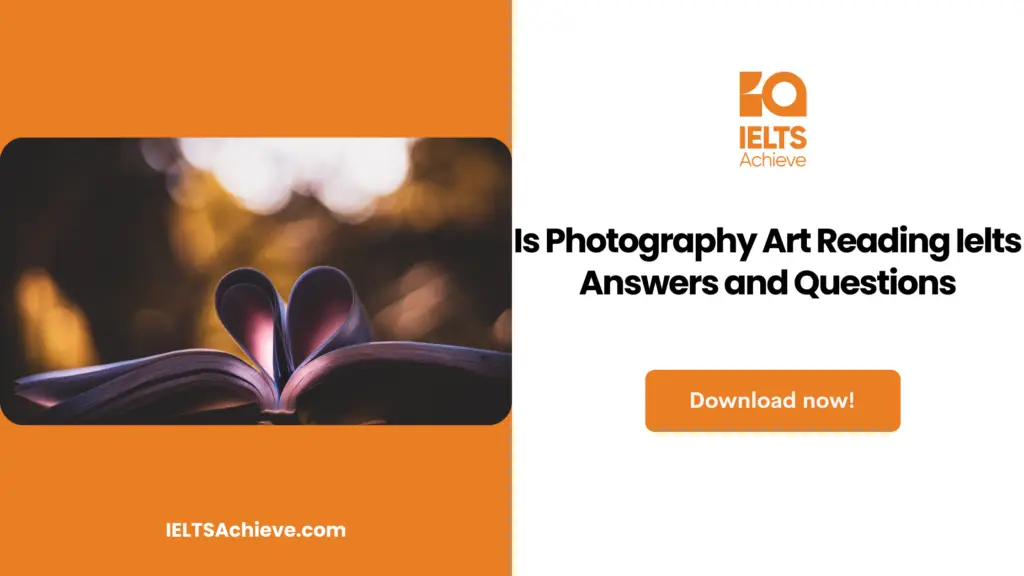The Blog post contains the following IELTS Reading Questions:
- IELTS Reading Summary Completion
- IELTS Reading Multiple Choice Questions
- IELTS Reading Matching Features
Stay informed and prepared for success – Explore our comprehensive Reading Test Info page to get valuable insights, exam format details, and expert tips for mastering the IELTS Reading section.
IELTS Reading Passage – Is Photography Art

Is Photography Art?
A. This may seem a pointless question today. Surrounded as we are by thousands of photographs, most of us take for granted that, in addition to supplying information and seducing customers, camera images also serve as decoration, afford spiritual enrichment, and provide significant insights into the passing scene. But in the decades following the discovery of photography, this question reflected the
B. The much-publicised pronouncement by painter Paul Delaroche that the daguerreotype* signalling the end of painting is perplexing because this clever artist also forecast the usefulness of the medium for graphic artists in a letter written in 1839. Nevertheless, it is symptomatic of the swing between the outright rejection and qualified acceptance of the medium that was fairly typical of the artistic establishment. Discussion of the role of photography in art was especially spirited in France, where the internal policies of the time had created a large pool of artists, but it was also taken up by important voices in England.
C. From the maze of conflicting statements and heated articles on the subject, about the emerged. The simplest, entertained by many painters and a section of the public, was that because they were made with a mechanical device and by physical and chemical phenomena instead of by human hand and spirit; to some, camera images seemed to have more in common with fabric produced by machinery in a mill than with handmade creations fired by inspiration. The second widely held view, shared by painters, some photographers, and some critics, was that but should not be considered equal in creativeness to drawing and painting. Lastly, by assuming that the process was comparable to other techniques such as etching and lithography, a fair number of individuals realised that camera images were or could be as significant as handmade works of art and that they might have a positive influence on the arts and on culture in general.
D. Artists reacted to photography in various ways. Many portrait painters – miniaturists in particular – some incorporated it with painting, while others renounced painting altogether. Still other painters, the most prominent among them the French painter, began almost immediately to use photography to make a record of their own output and also to provide themselves with source material for poses and backgrounds, vigorously denying at the same time its influence on their vision or its claims as art.
E. The view that photographs might be worthwhile to artists was enunciated in considerable detail by Lacan and The latter, an art and literary critic, who eventually recognised that camera images could be inspired as well as informative, suggested that they would lead to greater naturalness in the graphic depiction of anatomy, clothing, likeness, expression, and landscape. By studying photographs, true artists, he claimed, would be relieved of menial tasks and become free to devote themselves to the more important spiritual aspects of their work.
F. Wey left unstated what the incompetent artist might do as an alternative, but according to the influential French critic and poet , writing in response to an exhibition of photography in 1859, lazy and untalented painters would become photographers. Fired by a belief in art as an imaginative embodiment of cultivated ideas and dreams, Baudelaire regarded photography as ‘a very humble servant of art and science’; a medium largely unable to transcend ‘external reality’. For this critic, photography was linked with ‘the great industrial madness’ of the time, which in his eyes exercised disastrous consequences on the spiritual qualities of life and art.
G. was the most prominent of the French artists who welcomed photography as a help-mate but recognized its limitations. Regretting that ‘such a wonderful invention’ had arrived so late in his lifetime, he still took lessons in daguerreotype, and both commissioned and collected photographs. Delacroix’s enthusiasm for the medium can be sensed in a journal entry noting that if photographs were used as they should be, an artist might ‘raise himself to heights that we do not yet know’.
H. The question of whether the photograph was document or art aroused interest in England also. The most important statement on this matter was an unsigned article that concluded that while photography had a role to play, it should not be ‘constrained’ into ‘competition’ with art; a more stringent viewpoint led critic to dismiss camera images as ‘narrow in range, emphatic in assertion, telling one truth for ten falsehoods’. Technology made photographic images a common sight in the shop windows of Regent Street and Piccadilly in London and the commercial boulevards of Paris. In London, for example, there were at the time some 130 commercial establishments where portraits, landscapes, and photographic reproductions of works of art could be bought. This appeal to the middle class convinced the elite that photographs would foster a desire for realism instead of idealism, even though some critics recognized that the work of individual photographers might display an uplifting style and substance that was consistent with the defining characteristics of art.
Unlock your full potential in the IELTS Reading section – Visit our IELTS Reading Practice Question Answer page now!
Recommended Questions:
Renewable Energy IELTS Reading Question with Answer
Is Photography Art Reading Questions
Questions 27 – 30
Choose the correct letter, A, B, C or D. Write your answers in boxes 27-30 on your answer sheet.
27. What is the writer’s main point in the first paragraph?
A. photography is used for many different purposes.
B. photographers and artists have the same principal aims.
C. Photography has not always been a readily accepted art form.
D. photographers today are more creative than those of the past.
28. What public view about artists was shared by the French and the English?
A. that only artists could reflect a culture’s true values.
B. that only artists were qualified to judge photography.
C. that artists could lose work as a result of photography.
D. that artist success raised a country’s international profile.
29. What does the writer mean by “the handwriting on the wall” in the second line of paragraph 4?
A. an example of poor talent.
B. a message that cannot be trusted.
C. an advertisement for something new.
D. a signal that something bad will happen.
30. What was the result of the widespread availability of photographs to the middle classes?
A. The most educated worried about its impact on public taste.
B. It helped artists appreciate the merits of photography.
C. Improvements were made in photographic methods.
D. It led to a reduction in the price of photographs.
Ready to improve your performance in Multiple Choice Questions (MCQs)? Click here to access our comprehensive guide on how to tackle MCQs effectively in the IELTS Reading section.
Questions 31 – 34
Complete the summary of Paragraph 3 using the list of words, A-G, below. Write your answers in boxes 31-34 on your answer sheet.
A) inventive C) beneficial E) mixed G) inferior B) similar D) next F) justified
Camera art
In the early days of photography, opinions on its future were 31 ………………………., but three clear views emerged. A large number of artists and ordinary people saw photographs as 32 ………………………. to paintings because of the way they were produced. Another popular view was that photographs could have a role to play in the art world, despite the photographer being less 33…………………………. Finally, a smaller number of people suspected that the impact of photography on art and society could be 34………………………
Boost your performance in Summary, Notes, Table, and Flowchart Completion tasks. Click here to explore our detailed guide and learn how to effectively complete summaries, notes, tables, and flowcharts in the IELTS Reading section.
Questions 35 – 40
Look at the following statements and the list of people, A-I, below. Match each statement with the correct person. Write the correct letter, A-I, in boxes 35 – 40 on your answer sheet.
35. He claimed that photography would make paintings more realistic.
36. He highlighted the limitations and deceptions of the camera.
37. He documented his production of artwork by photographing his works.
38. He noted the potential for photography to enrich artistic talent.
39. He based some of the scenes in his paintings on photographs.
40. He felt photography was part of the trend towards greater mechanisation.
A. Jean-Auguste-Dominique Ingres
B. Francis Wey
C. Charles Baudelaire
D. Eugene Delacroix
E. Philip Gilbert Hamerton
Improve your performance in Matching Features questions by clicking here to access our comprehensive guide. Learn how to match specific features or characteristics with the options provided in the IELTS Reading section.
Unlock your full potential in the IELTS Reading section – Visit our IELTS Reading Practice Question Answer page now!
Recommended Questions:
Renewable Energy IELTS Reading Question with Answer
Is Photography Art Reading Answers
27. Answer: C
28. Answer: D
29. Answer: D
30. Answer: A
31. Answer: E
32. Answer: G
33. Answer: A
34. Answer: C
35. Answer: B
36. Answer: E
37. Answer: A
38. Answer: D
39. Answer: A
40. Answer: C

We hope you found this post useful in helping you to study for the IELTS Test. If you have any questions please let us know in the comments below or on the Facebook page.
The best way to keep up to date with posts like this is to like us on Facebook, then follow us on Instagram and Pinterest. If you need help preparing for the IELTS Test, join the IELTS Achieve Academy and see how we can assist you to achieve your desired band score. We offer an essay correction service, mock exams and online courses.


